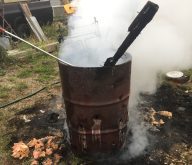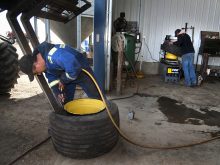CORRECTION – February 7, 2020 – GSI and Winnipeg-based 151 Research are partnering to bring GrainViz, a revolutionary new grain monitoring system, to market. The original version of this story incorrectly stated that GSI had purchased GrainViz from 151 Research.
The drawn-out 2019 harvest forced farmers to store grain at high moisture levels. This increases risk of entrapment or death when entering bins to deal with quality issues or plugged augers.
The most common accident occurs when a farmer enters the top of a bin and walks on the surface to check grain, says Gary Woodruff, grain conditioning specialist with GSI.
Read Also

Growing garlic by the thousands in Manitoba
Grower holds a planting party day every fall as a crowd gathers to help put 28,000 plants, and sometimes more, into theground
“You run the risk of the crust breaking and tumbling into the grain. You quickly become engulfed,” says Woodruff.
“That’s why we always preach a policy of zero entry. But if a farmer decides he must go in there anyway, there are precautions he should take. There are three critical things to remember.”
- Wear a rope and harness to prevent falling into grain if the surface breaks.
- Always have a spotter present who can call for emergency assistance if entrapment should happen.
- Lock out all electrical controls so augers cannot run when a person is in the bin.
Woodruff says grain stored above 15 percent moisture is often neglected because of insufficient drying capacity or because the farmer depends only on aeration. This can cause the grain to degrade in the bin and become more susceptible to mould.
“Grain went into bins at a lower quality, higher moisture and with more fines this fall, which makes this year much more dangerous for farmers. That’s why we always emphasize that farmers should never enter a bin when there is a risk of becoming entrapped.”
Woodruff recommends that farmers regularly check the quality of their grain this winter. In addition to grain monitoring devices, farmers should visually inspect their grain at least every other week.
“Climb up to the bin manhole. Without entering, look at the grain surface to see if there is crusting or any off-smells that may indicate a mould issue. Most problems show up on the surface first. It’s best if a sample from the surface is checked for moisture. Any increase in moisture indicates condition problems in the bin.”
Woodruff says new monitoring technology is currently in development. GSI and Winnipeg-based 151 Research are partnering to bring GrainViz to market, which may further help monitor and manage grain. Farmers will be able to remotely create a three-dimensional moisture map using technology similar to MRI or CT scans. Operators can see the moisture content of each individual bushel of grain and its location within the grain mass, without having to enter the bin.

Woodruff notes that the only real fix for out-of-condition grain is to unload the bin down to where the affected grain can be removed. This likely means the grain will have to be marketed early. Producers can expect poor quality and will likely be penalized at the elevator.
If the grain is too out of condition to sell, it will need to be dumped back in the field.
It seems the entire grain-handling industry is echoing the same message this winter.
Gord Braun is president of the Canadian Prairies chapter of the Grain Elevator and Processing Society as well as an executive with Parrish and Heimbecker in Winnipeg. In a phone interview, Braun said there’s a human risk in every bin that’s holding high moisture grain this winter.
“This grain has a tendency to stand up in the bin and create solid walls and cliffs of hung-up grain. You don’t know when it’s going to come down and bury you,” warns Braun.

“Even if you’re fully harnessed up, those cliffs might be 25 or 30 feet tall, and there’s no warning when they decide to let go. You could be in there with a 20-foot wall above you, and if it lets go, you could be totally buried in seconds.
“You slowly sink into the grain, even if it’s out in a pile on the ground. By the time you’re in up to your waist, there’s no way to get yourself out of it. This was not a big deal back when we had a lot of smaller bins on the farm. But now, it’s a totally different story.”
Man dies after fall into grain bin
A man died Jan. 29 after falling into a grain bin at a farm in Stearns County near St. Martin, Minnesota, according to sheriff’s officials.
Firefighters recovered the victim in the bin, which was nearly full of corn.
He was identified as 35-year-old Brandon Schaefer of Albany.
An investigation found Schaefer was trying to loosen frozen corn in the bin when he fell in and was buried.
Source: Associated Press



















